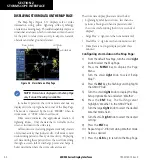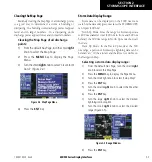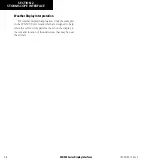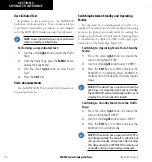
400/500 Series Display Interfaces
4-3
SECTION 4
RYAN TCAD INTERFACE
Monitoring Traffic
Refer to the information in the TCAD Pilot’s Guide
regarding monitoring traffic on the display and the
corresponding actions to take.
Highlighting Traffic Data Using Map Panning
Panning is another map page function, which allows
moving the map beyond its current limits without
adjusting the map scale. Select the panning function—by
pressing the small
right
knob—a target pointer flashes on
the map display. Also a window also appears at the top of
the map display showing the latitude/longitude position
of the pointer, and the bearing and distance to the pointer
from the present position.
When the target pointer is placed on traffic, the traffic
range, altitude separation, squawk code (if available), and
tail number (if available) are displayed (Figure 4-4).
Panning the map:
1) Press the small
right
knob to activate the
panning target pointer (Figure 4-4).
Figure 4-4 Panning the Map Page
2) Turn the small
right
knob to move up (turn
clockwise), or down (turn counterclockwise).
3) Turn the large
right
knob to move right (turn
clockwise), or left (turn counterclockwise)
4) Press the small
right
knob to cancel map
panning and return to the present position, .
The traffic is identified as follows:
• TA: Traffic Advisory—This is traffic within 500
ft. of altitude separation that is converging or
maintaining altitude separation.
• PA: Proximity Advisory—This is traffic within 500
ft. of separation and it is not a TA.
• TRFC:—Other traffic
190-00140-10 Rev. E




















